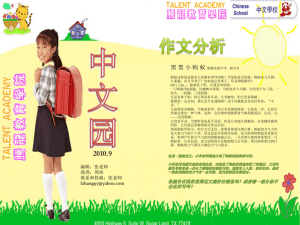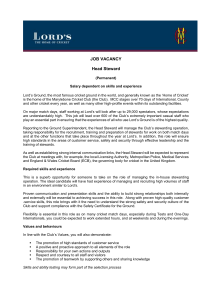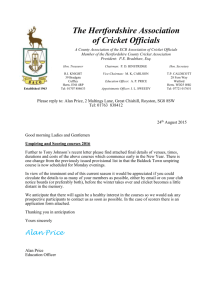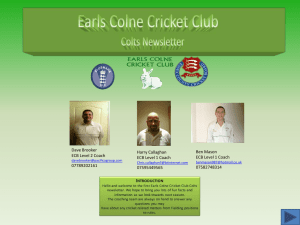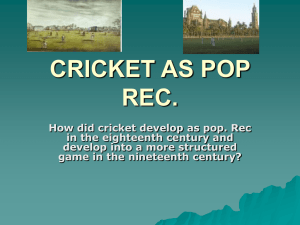gfgfgf - Toowong and District Historical Society
advertisement
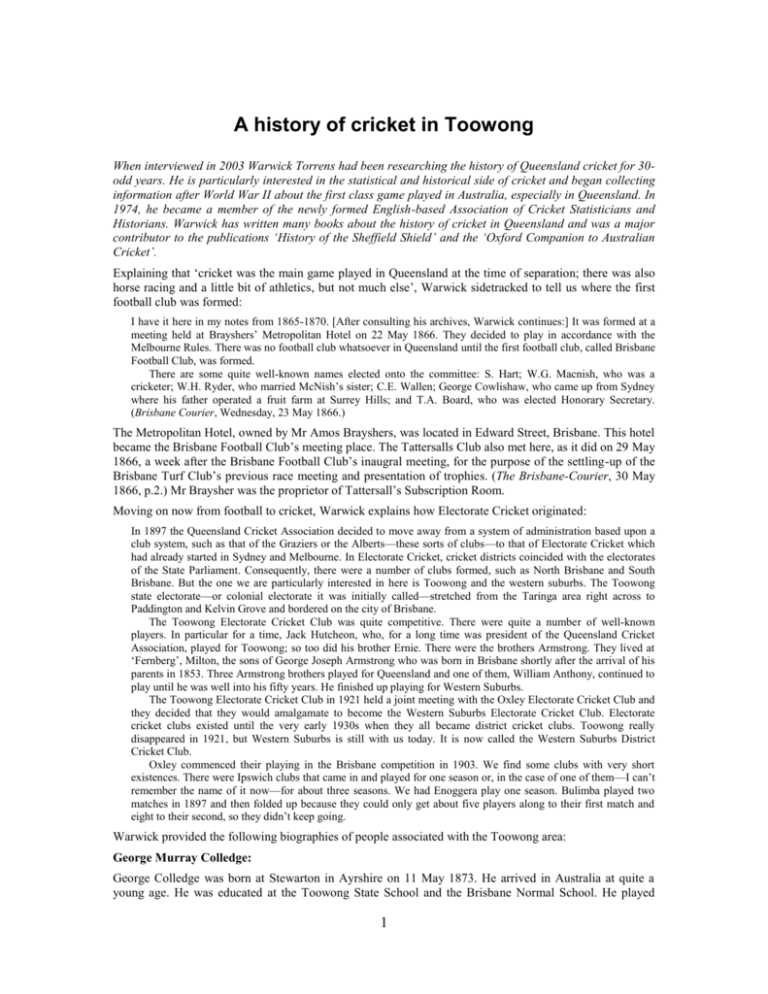
A history of cricket in Toowong When interviewed in 2003 Warwick Torrens had been researching the history of Queensland cricket for 30odd years. He is particularly interested in the statistical and historical side of cricket and began collecting information after World War II about the first class game played in Australia, especially in Queensland. In 1974, he became a member of the newly formed English-based Association of Cricket Statisticians and Historians. Warwick has written many books about the history of cricket in Queensland and was a major contributor to the publications ‘History of the Sheffield Shield’ and the ‘Oxford Companion to Australian Cricket’. Explaining that ‘cricket was the main game played in Queensland at the time of separation; there was also horse racing and a little bit of athletics, but not much else’, Warwick sidetracked to tell us where the first football club was formed: I have it here in my notes from 1865-1870. [After consulting his archives, Warwick continues:] It was formed at a meeting held at Brayshers’ Metropolitan Hotel on 22 May 1866. They decided to play in accordance with the Melbourne Rules. There was no football club whatsoever in Queensland until the first football club, called Brisbane Football Club, was formed. There are some quite well-known names elected onto the committee: S. Hart; W.G. Macnish, who was a cricketer; W.H. Ryder, who married McNish’s sister; C.E. Wallen; George Cowlishaw, who came up from Sydney where his father operated a fruit farm at Surrey Hills; and T.A. Board, who was elected Honorary Secretary. (Brisbane Courier, Wednesday, 23 May 1866.) The Metropolitan Hotel, owned by Mr Amos Brayshers, was located in Edward Street, Brisbane. This hotel became the Brisbane Football Club’s meeting place. The Tattersalls Club also met here, as it did on 29 May 1866, a week after the Brisbane Football Club’s inaugral meeting, for the purpose of the settling-up of the Brisbane Turf Club’s previous race meeting and presentation of trophies. (The Brisbane-Courier, 30 May 1866, p.2.) Mr Braysher was the proprietor of Tattersall’s Subscription Room. Moving on now from football to cricket, Warwick explains how Electorate Cricket originated: In 1897 the Queensland Cricket Association decided to move away from a system of administration based upon a club system, such as that of the Graziers or the Alberts—these sorts of clubs—to that of Electorate Cricket which had already started in Sydney and Melbourne. In Electorate Cricket, cricket districts coincided with the electorates of the State Parliament. Consequently, there were a number of clubs formed, such as North Brisbane and South Brisbane. But the one we are particularly interested in here is Toowong and the western suburbs. The Toowong state electorate—or colonial electorate it was initially called—stretched from the Taringa area right across to Paddington and Kelvin Grove and bordered on the city of Brisbane. The Toowong Electorate Cricket Club was quite competitive. There were quite a number of well-known players. In particular for a time, Jack Hutcheon, who, for a long time was president of the Queensland Cricket Association, played for Toowong; so too did his brother Ernie. There were the brothers Armstrong. They lived at ‘Fernberg’, Milton, the sons of George Joseph Armstrong who was born in Brisbane shortly after the arrival of his parents in 1853. Three Armstrong brothers played for Queensland and one of them, William Anthony, continued to play until he was well into his fifty years. He finished up playing for Western Suburbs. The Toowong Electorate Cricket Club in 1921 held a joint meeting with the Oxley Electorate Cricket Club and they decided that they would amalgamate to become the Western Suburbs Electorate Cricket Club. Electorate cricket clubs existed until the very early 1930s when they all became district cricket clubs. Toowong really disappeared in 1921, but Western Suburbs is still with us today. It is now called the Western Suburbs District Cricket Club. Oxley commenced their playing in the Brisbane competition in 1903. We find some clubs with very short existences. There were Ipswich clubs that came in and played for one season or, in the case of one of them—I can’t remember the name of it now—for about three seasons. We had Enoggera play one season. Bulimba played two matches in 1897 and then folded up because they could only get about five players along to their first match and eight to their second, so they didn’t keep going. Warwick provided the following biographies of people associated with the Toowong area: George Murray Colledge: George Colledge was born at Stewarton in Ayrshire on 11 May 1873. He arrived in Australia at quite a young age. He was educated at the Toowong State School and the Brisbane Normal School. He played 1 cricket for the Toowong Electorate Cricket Club and probably also there was a Toowong club playing in the junior division prior to the establishment of electorate clubs. He was the secretary of the Queensland Cricket Association from 1897 to 1908. He was also a member of the QCA Executive for a short time. He was an Australian Cricket Board delegate for Queensland from 1905 to 1907 and he was granted life membership of the Queensland Cricket Association on 17 August 1909. George died at the Beerwah Private Hospital at Gregory Terrace, Fortitude Valley on 18 June 1951. That’s on the corner of Brunswick Street and Gregory Terrace. George’s parents were Matilda Ann (nèe Broomfield) and George Murray Colledge, Stationmaster and I understand George Jnr also worked in the railways. At least one of his sons played quite good cricket but moved around the State quite a bit and played in country areas. I think Warwick is one where I’ve come across him playing. James William Adams: As a Queensland cricketer I suppose you could say of not great note, but he did play one game for Queensland. James William Adams was born at Toowong on 22 February 1904. Adams was educated at the Brisbane Grammar School, but didn’t play cricket seriously for a number of years until he was getting up towards his mid-20s because he was quite involved in the Citizens Military Forces. Adams was the son of Herbert James William Huxtable Adams and Lillian Kate (nèe Frost). His father was a tailor in Toowong. Jim Adams worked for a time for Finney Isles & Co. and, just prior to the Second World War, moved to Melbourne, and later to Sydney where he died on 9 January 1988. He was 12th man for Queensland in the game when Eddie Gilbert dismissed Bradman, caught by Len Waterman, without scoring. That game was in February 1931, and was the first Sheffield Shield match played at the Brisbane Cricket Ground. He had played for Queensland against the West Indies in the previous season. That was his game. He missed a game after that West Indies game when the match between Queensland and Victoria was completely washed out by continuous rain. That game was to be played at the Brisbane Cricket Ground and should have been the first Sheffield Shield match at the Brisbane Cricket Ground. The next game was in November 1931. Adams, at one stage, lived at Victoria Crescent, Toowong.1 I believe he attended Toowong State School. Bill Abell: Bill Abell was born in Leeds in England and came out here, quite obviously, at a fairly young age. I do find him on the electoral rolls being aged 22 on 23 March 1897. Bill’s mother was listed as Mrs Lonsdale Abell living at Stanley Terrace, Taringa. There was a Lonsdale Abell who died on 20 May 1884 and so I can only assume that this is the husband of Mrs Abell. There was a Henry Lonsdale Abell who died on 10 August 1912 and who is shown in the Queensland death indexes as the son of Lonsdale Abell and Mary Slater. So that would be Bill’s brother and his parents. Mrs Mary Abell is shown as the proprietor of a private school in Toowong. I haven’t really gone very much further than that except that we know Bill enlisted in the Boer War as a private in Unit 6 of the Queensland Imperial Bushmen Contingent. And he also went off to the First World War. I’m not quite sure if he was the one who joined the 11th Light Horse or the 14th Battalion, presumably the first. It does seem that he altered his birth year by a couple of years because records do show that he was born in 1876, but the correct year would appear to be 1874. Bill died in 1960 at the War Veterans Home at Caboolture. I just haven’t got a date here for that at the moment. Dixon family: Joseph Black Dixon moved to Brisbane in 1860 as the accountant of the newly opened Brisbane branch of the Bank of Australasia. He was the son of a banker, Joseph Dixon in Hobart, and he came up here and virtually stayed here except in 1869 he moved for a short period to accountant at Sydney, and within 12 months was transferred back to Brisbane as the manager of the Brisbane branch. In 1869 he married Louise Jane Sloan2, who came from Maitland and there were six children. Now Joseph had a health problem and he died in 1881, the youngest of his family was just over 15 months old at the time of his death. Mrs Dixon had to find an income to look after her six children and so she took on a boarding house at Toowong. This 2 was apparently a place that was quite well known. She did quite well with the family. Four of the boys attended Brisbane Grammar School and did quite well. One became a doctor, one became a banker and the one who became a banker was Joseph Eric. His son, Patrick Leslie Dixon (‘Les’), played cricket for Queensland and also rugby and, in fact, was in line for an Australian Rugby cap when he was injured and decided that cricket was more to his liking than the injuries of Rugby. Les was a prisoner of war of the Germans in the Second World War. He joined the RAAF and was shot down over Germany. Two of Joseph’s brothers came to Brisbane, Laurison and Grahame Dixon, who worked for the Bank of New South Wales. Then there was Russel (with one ‘l’ in Russel); at least, I believe that is correct. He worked in the Queensland Civil Service as it was called back in those years, and lived in Brisbane until his death in 1922. Laurison died in 1932. Both actually played cricket for Queensland in the pre first-class days, Russel actually appearing against the first ever English team that visited Queensland. I don’t know where Russel lived. I haven’t located that at this time, but Laurison lived at Auchenflower and that was where he died. The four sons of Joseph attended the Brisbane Grammar School and this is probably where they obtained a lot of their sporting prowess but, quite obviously, it was also a natural talent. Two of them were quite good rugby players as well as being cricketers. One of Laurison’s sons was quite a good cricketer and played grade cricket for Woolloongabba Electorate Cricket Club, and his life was lost in the First World War. William Stewart Dixon was the one who lost his life in the First World War. I don’t know anything about the family of Russel except that I have some names, but no other information about them. Les Dixon—all of his children were quite good at sports, the girls included. They played hockey. His son was the captain of the University of New South Wales cricket team in the Sydney grade competition. He represented New South Wales Colts and was at one time a member of the New South Wales squad. He was also a very good rugby player so that the sporting ability continued down. I haven’t heard anything about it continuing to a next generation as yet. Thank you to Warwick Torrens who was interviewed by Leigh Chamberlain on 28 January 2003 1 Victoria Crescent runs between Milton Road and Morley Street. Mrs Dixon’s death entry gives her name as Louisa Jane Dixon. She died in 1939, and her parents were David Sloan and Isabella Augusta Phillips. Extracted on 4 August 2014 from https://www.bdm.qld.gov.au 2 3


